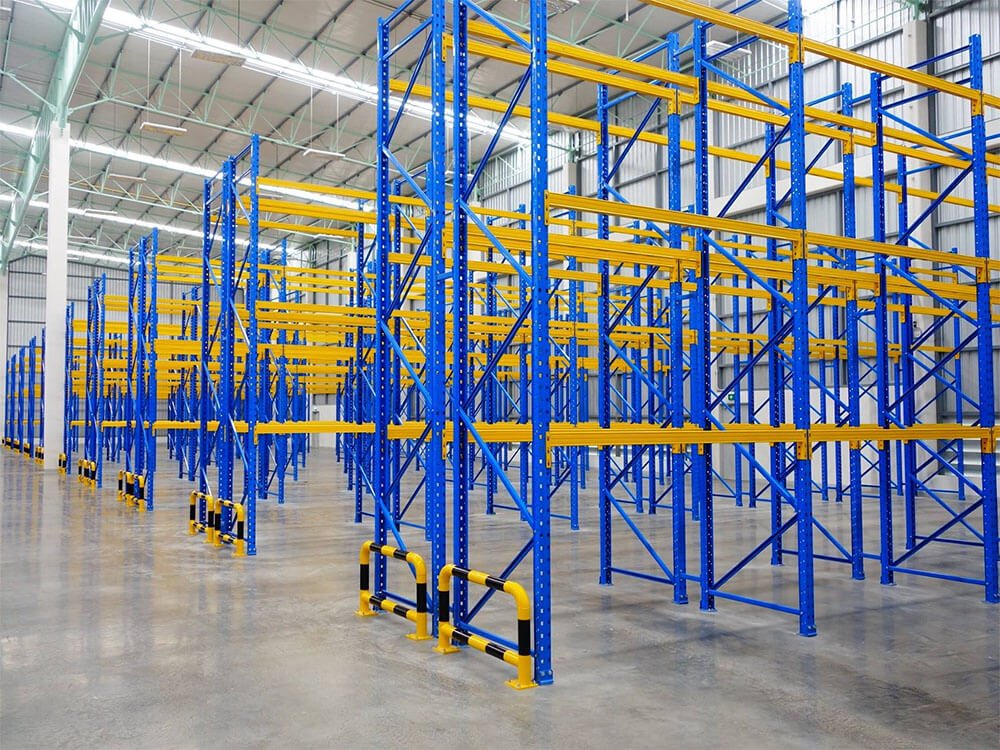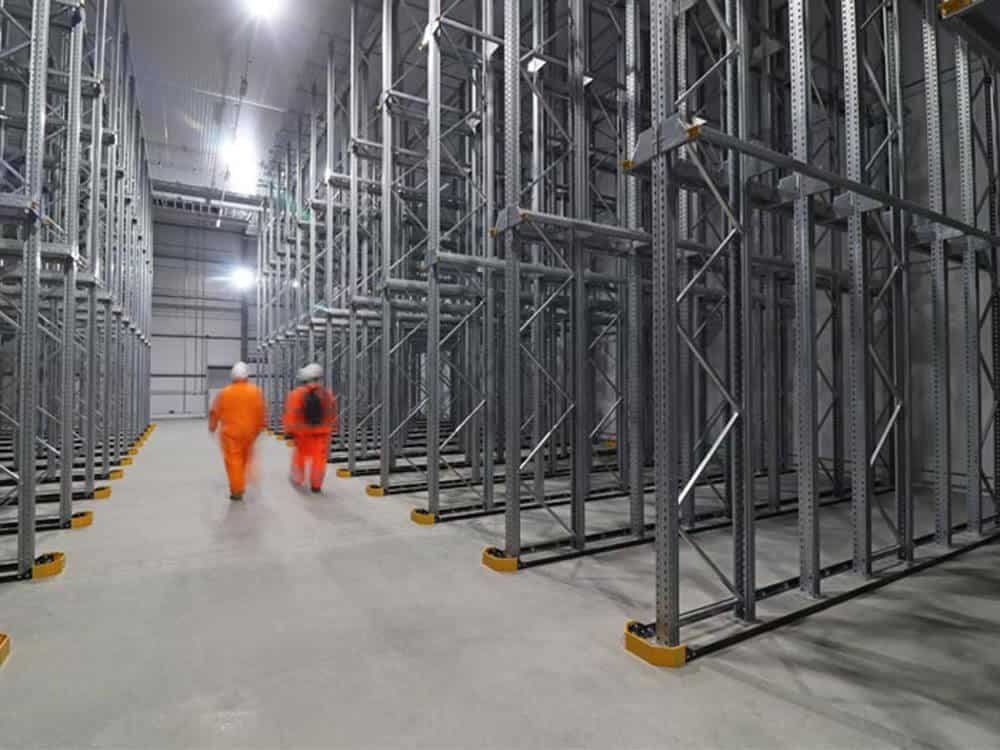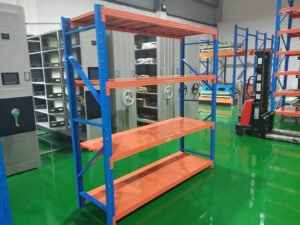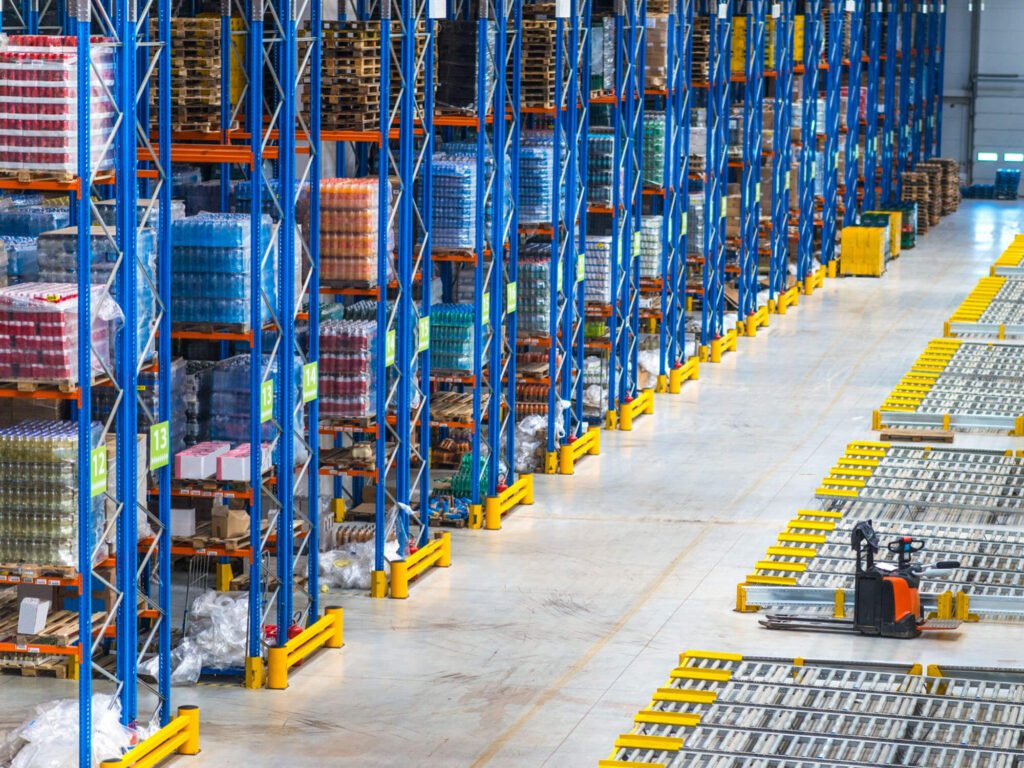In the vast world of the pallet racking system, the matchup between galvanized pallet racking vs steel pallet racking is one of the most fascinating cases. Without proper understanding of both types, you’ll have a hard time deciding which one is more suitable for your warehouse.
Consider it like picking the correct tool for the job: you wouldn’t use a hammer to drive a screw, would you? It’s the same with pallet racking. Factors, such as the material of your racks, their initial costs, their resistance to the weather, and even their intended applications, all make a difference.
This in-depth article will go over the pros and cons of each racking system, how they’re put together, and even particular situations where one outperforms the other. After reading, you’ll be well-prepared to choose the storage solution that best meets your demands and budget.
What Is Steel Pallet Racking?

Steel pallet racks are indispensable storage solutions that are implemented by numerous warehouses and industrial sites worldwide. As the name suggests, all elements of this racking structure, including vertical frames, horizontal beams, and bracing components, are constructed from steel.
This fundamental structure is suitable for a wide range of applications due to the steel design’s durability and strength, which are necessary to support substantial weights.
In addition, steel pallet racks are available in a variety of configurations, including selective pallet racks, drive-in pallet racks, push-back pallet racks, and pallet flow racks. Each type provides unique advantages that are contingent upon the facility’s specific storage and material management needs.
Steel pallet racking systems are frequently employed in industrial facilities and warehouses to ensure the efficient storage and accessibility of large quantities of palletized items. Well, here’s another great thing! They’re also suitable for cold storage facilities due to their ability to withstand low temperatures.
PROs:
Steel pallet racks can be the most prudent decision for any inventory facility due to their numerous advantages below:
- Saving money: This basic racking system is less costly than other types of storage solutions thanks to their straightforward production process. Cost-effectiveness renders them an appealing alternative for organizations that are restricted by financial constraints.
- Offering high adaptability: This advantage is a critical factor in the decision-making process for businesses investigating steel racks for their warehouses. Customizable and adaptable steel pallet racks are capable of meeting their requirements, regardless of their storage demands and layout.
- Providing top-notch durability: Steel is a durable material that can withstand significant weights and is resistant to normal wear and tear. This is the reason why numerous organizations select steel racks as their long-term storage solution.
CONs:
You may be wondering that if such an ideal storage system exists, then why are there still many different racking types out there? To address your inquiry, let’s have a look at some shortcomings of steel pallet racks
The first shortcoming of steel racks is that they’re not suitable for outdoor applications, especially in high-moisture environments. Another drawback is that steel pallet racks are prone to corrosion, which can seriously shorten their lifespan.
Exploring Galvanized Pallet Racking Systems

Galvanized racks are essentially steel pallet racks that have been enhanced with an additional layer of protection. A zinc plating, which is applied through the process of galvanization, serves as this protective layer. Galvanized racks are not only distinguished by their brilliant silver appearance, but their durability are also significantly enhanced.
Steel’s primary adversaries in severe environments are rust and corrosion, which the zinc coating serves as a safeguarding barrier. It provides protection to the underlying steel from corrosion factors, thereby ensuring the racking system’s structural integrity over time.
This zinc armor also helps defend the storage structures from outward attacks and increase their general strength. This makes them a popular outdoor pallet racking option in locations where corrosion is a significant problem. They’re also employed in sectors like food processing and cold storage, where high humidity and frequent washing may accelerate corrosion.
PROs:
There must be a reason why people undergo such a sophisticated production process to have galvanized racks. Let’s take a look at some superior advantages that these storage solutions bring to your warehouse:
- Exceptional corrosion resistance: This advantage is what makes galvanized racks different from steel racks. The zinc coating of galvanized racking systems shields the steel underneath from various corrosive factors, thereby increasing the storage system’s durability.
- Low maintenance: Because of the protective zinc coating, galvanized racks demand fewer upkeep efforts. They’re less prone to rusting and wear, thus minimizing the need for regular cleaning, painting, and repairs. This results in huge long-term cost reductions for organizations.
- Enhanced safety: The zinc coating also reduces the possibility of structural collapse due to corrosion, which can cause accidents and injuries in the warehouse.
- Long lifespan: Galvanized racks have a much longer lifespan than regular steel racks. Thanks to the safeguard of the zinc layer against degradation, these racking solutions can perform well for many years, thus eliminating the need for regular replacements.
CON:
The biggest disadvantage of galvanized pallet racking systems is their greater initial cost compared to normal steel racks. The galvanization process adds another stage to the production procedure, thereby raising the final expense.
Yet, the long-term benefit of galvanized racks often outweighs the high upfront cost. Their extended life, minimal maintenance needs, and lower risk of expensive replacements make them an economical option in the long run.
Galvanized Pallet Racking VS Steel Pallet Racking: Head-To-Head Comparison
This part is the reason why you searched for the article in the first place. Here, you’ll explore in detail all the key differences between galvanized pallet racking vs steel pallet racking. The matchup will help you understand both storage systems deeper.
#1: Material Composition
Both steel and galvanized racking systems are built from steel, a strong and versatile material recognized for its load-bearing capabilities. This makes them ideal for heavy-duty storage in warehouses and industrial environments.
Yet, the essential distinction is the protective covering. Galvanized racks undergo an additional step where they’re coated with a layer of zinc. This zinc coating functions as a barrier, safeguarding the underlying steel from direct contact with moisture and other corrosive substances.
In contrast, steel pallet racks often lack this protective covering. While they can be painted or treated with different coatings, they don’t provide the same degree of corrosion resistance as zinc. This makes steel racking systems more vulnerable to rust and deterioration, especially in humid settings.
#2: Cost
Steel pallet racking often requires a lesser initial expenditure thanks to its simple production method. This may be appealing to enterprises with limited resources or those looking for urgent storage options.
While steel may seem like a cheaper option at first, it’s vital to examine the long-term expenses. Steel is prone to rusting and corrosion, particularly in humid situations or when exposed to certain chemicals. Over time, this might result in expensive repairs or perhaps total replacements.
On the other hand, galvanized racking systems demand higher upfront prices. This is due to the extra step of putting a zinc coating to the steel, also known as galvanization. This coating considerably improves the rack’s rust and corrosion resistance, perhaps leading to a longer lifetime and cheaper long-term maintenance costs.
#3: Durability And Corrosion Resistance
Durability is an important consideration when selecting pallet racking since it affects the longevity and total worth of your investment. Steel pallet racking is naturally sturdy and can withstand heavy loads, although it’s susceptible to corrosion.
Rust can erode the structural integrity of steel racks, jeopardizing their safety and load-bearing capability. Steel racking may degrade quickly in humid settings or in companies that work with corrosive chemicals, necessitating regular repairs or replacement.

Galvanized racks were particularly intended to alleviate this problem. The zinc coating serves as a sacrificial layer, shielding the underlying steel from rusting and corrosion. This makes galvanized racking systems very robust, especially in harsh situations. They can tolerate exposure to moisture, chemicals, and even external elements without losing structural integrity.
#4: Strength And Load Capacity
In terms of strength and load capacity, both galvanized racks and steel pallet racking systems function well. They’re designed to support heavy loads and can accept a wide variety of pallet dimensions and weight arrangements.
The decision between them is generally determined by the unique needs of your warehouse or storage facility. If you want to store particularly heavy loads or if your warehouse has special structural requirements, consult with a racking expert to identify the best choice.
In general, galvanized and steel pallet racking can be tailored to individual load capacity requirements. You can customize them with various beam diameters, upright heights, and bracing choices to maximize inventory space and ensure the safety of your goods.
#5: Applications And Ideal Environments
Steel pallet racking is a flexible workhorse that can be used for a variety of interior applications. It’s widely utilized in warehouses, distribution centers, industrial facilities, and retail establishments. This racking type works brilliantly in dry, non-corrosive environments.
However, if your storage area is exposed to dampness, chemicals, or external conditions, galvanized pallet racking systems are the better option. These outdoor pallet racking solutions have remarkable corrosion resistance, making them perfect for use in food processing, cold storage, chemical manufacturing, and outdoor storage yards.
Galvanized racks can survive severe environments that would soon corrode steel pallet racking systems. This not only protects the lifespan of your storage system but also helps create a safer working environment by minimizing structural failures caused by rust and corrosion.
#6: Maintenance Requirements
Maintenance is an ongoing concern for any pallet racking system. While both galvanized and steel racks need frequent inspections to maintain their safety and functionality, their maintenance requirements vary dramatically.
Steel pallet racking requires special care owing to its susceptibility to corrosion. In humid locations, periodic cleaning and rust prevention treatments are necessary to keep the rack in good condition. Scratches and chips in the paint can expose the underlying steel to moisture, hastening the corrosion process.
Galvanized racking systems, with their protective zinc covering, need very little upkeep. The zinc layer works as a rust barrier, even if the surface is scraped or chipped. This equates to fewer inspections and maintenance activities, ultimately saving you time and money.
#7: Aesthetics
While utility and durability are often the key considerations when selecting pallet racking solutions, aesthetics is also important, particularly if your warehouse is customer-facing or if you value a contemporary and clean appearance.
Steel pallet racking has a normal industrial look with a painted finish that may come in various colors. While useful, it’s not the most visually pleasing choice.

With their bright silver finish, galvanized racks have a more modern appearance. The zinc coating gives the racks a sleek, contemporary look, which improves the overall appearance of your warehouse. Plus, the shiny surface of galvanized racks can increase visibility in low-light situations, thus facilitating a safer working environment.
Galvanized Pallet Racking VS Steel Pallet Racking: Summary Table
If you find the above matchup a bit overwhelming to digest, don’t worry, as the following summary table will help you catch up on everything quickly. The table contains key points that differentiate steel racks from galvanized racks.
| Criteria | Galvanized Racks | Steel Racks |
|---|---|---|
| Material Composition | Steel with a zinc coating | Steel only |
| Cost | Higher upfront costs | Lower upfront costs |
| Durability | More durable and corrosion-resistant | Less durable and more susceptible to corrosion |
| Load Capacity | Similar load capacity | Similar load capacity |
| Applications | Ideal for harsh environments, outdoor storage, and cold storage | Well-suited for dry settings and indoor inventory |
| Maintenance Demands | Low requirement for maintenance | Higher maintenance needs |
| Aesthetics | Shiny, silver finish | Industrial gray finish |
Practical Tips To Choose Between Steel And Galvanized Racks
Choosing between steel and galvanized pallet racking systems doesn’t have to be a difficult undertaking. By taking into account your individual requirements and priorities, you can make an informed decision about your storage solution. Here are some practical recommendations to help you navigate the selection process:
- Assessing your surroundings: Determine if your inventory space is indoors or outdoors and whether it’s subjected to moisture, humidity, or corrosive chemicals. Galvanized racks are best for tough situations, whilst steel racks are better suited to dry interior settings.
- Considering your budget: Steel pallet racking often has a cheaper initial cost. Yet, galvanized racks provide long-term savings owing to their longevity and minimal maintenance needs. Evaluate your budget and objectives to find the best cost-effective solution for you.
- Evaluating your load requirements: Both steel and galvanized racks have high strength and load capacity. However, if you want to store particularly high loads or have special structural requirements, contact a racking professional to verify that the selected system will securely satisfy your demands.
- Factoring in aesthetics: While not a key consideration for most warehouses, aesthetics can still be important. If you want a contemporary and visually attractive storage solution, galvanized racks with a polished finish can be a better option.
- Prioritizing maintenance: If minimal maintenance is a goal, galvanized racks are the apparent choice. When compared to steel racks, their corrosion resistance means fewer inspections and repairs are required.
- Thinking long-term: Consider each system’s lifespan and total cost of ownership. While galvanized racks are more expensive initially, their durability and minimal upkeep needs can result in considerable long-term savings.
- Seeking expert advice: In case you’re still unclear about which sort of pallet racking system is better for you, don’t hesitate to talk with a specialist. They can assess your unique requirements and provide the optimal solution for your warehouse.
Conclusion
Congratulations! You’ve fully conquered the matchup between galvanized pallet racking vs steel pallet racking. Although both storage systems play important roles in contemporary warehouses, each kind has various benefits and limitations, making them well-suited for distinct applications and inventory settings.
Steel pallet racks, with their economy and versatility, remain a popular option for organizations looking for a low-cost storage solution. However, their sensitivity to rust and corrosion restricts their usefulness in severe situations.
On the other hand, galvanized racks thrive in harsh environments because of their outstanding longevity and corrosion resistance. While this outdoor pallet racking system has a larger upfront expense, its long-term advantages often surpass the investment.
By carefully evaluating the aspects described in this article, you can make an educated selection that improves your warehouse operations while also ensuring the lifespan of your storage system. Thanks for reading!




